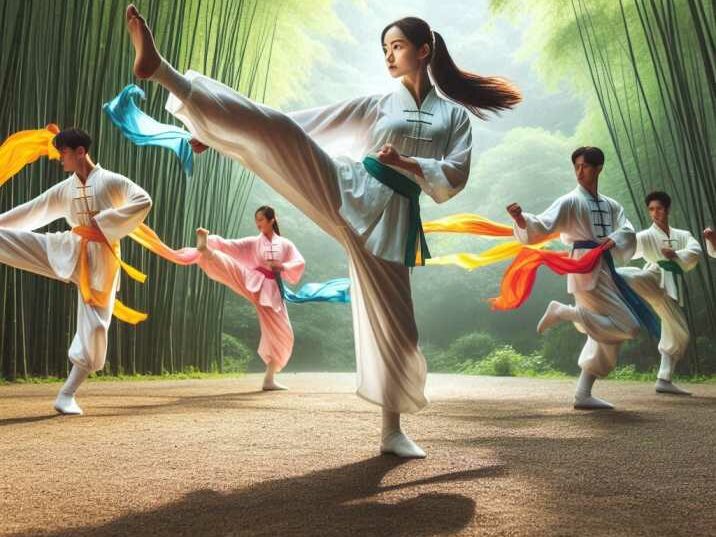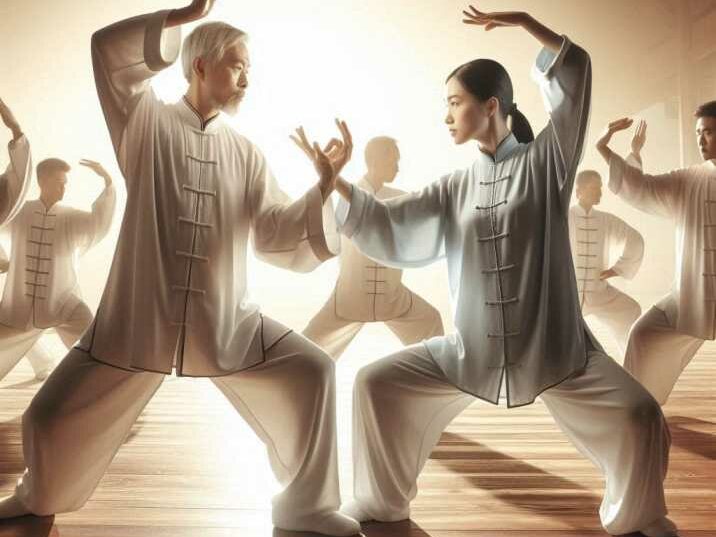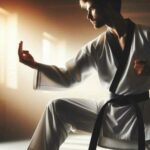Introduction
Table of Contents
Chinese martial arts, often referred to as Kung Fu or Wushu, encompass a broad range of styles and practices. These disciplines are not only physical but also deeply rooted in Chinese culture and philosophy. Understanding the terminology used in Chinese martial arts is essential for anyone who wants to truly appreciate the art form. This guide aims to provide a detailed overview of key terms, their meanings, and their significance within the martial arts community. Whether you’re a practitioner, enthusiast, or simply curious, this article will help you navigate the rich linguistic landscape of Chinese martial arts.

The Importance of Terminology in Chinese Martial Arts
The language of Chinese martial arts is rich and nuanced, reflecting the depth and history of the practices. Terminology is more than just words; it encapsulates techniques, philosophies, and cultural elements that are integral to the martial arts experience. Understanding these terms helps practitioners connect more deeply with the art, respect its traditions, and communicate effectively within the community.
Common Terms and Their Meanings
1. Wushu (武术)
Definition:
Wushu literally means “martial art” in Chinese. It is the term used in modern China to refer to all forms of Chinese martial arts, encompassing a vast array of traditional and contemporary styles. The term “Wushu” integrates the characters “Wu” (武) meaning martial or military and “Shu” (术) meaning art or skill, thereby signifying the art of combat.
Significance:
Wushu holds a significant place in Chinese culture, symbolizing both physical prowess and artistic expression. It includes a wide variety of styles and techniques, from traditional forms passed down through generations to modern adaptations designed for competitive sports. Wushu is recognized as an international sport, with standardized rules and competitions that showcase the athletic and aesthetic elements of martial arts. Practitioners train in forms (Taolu) and sparring (Sanda), emphasizing both solo performance and combat skills. As a sport, Wushu aims to preserve the rich heritage of Chinese martial arts while adapting to contemporary athletic standards.
2. Kung Fu (功夫)
Definition:
Kung Fu translates to “skill achieved through hard work” in Chinese. The term “Kung Fu” is composed of “Gong” (功), meaning work, achievement, or merit, and “Fu” (夫), meaning man or person. In its broadest sense, Kung Fu refers to any skill developed through diligent practice and effort. While commonly used in the West to refer to Chinese martial arts, in China, it can describe any endeavor requiring time and perseverance to master, such as cooking, painting, or music.
Significance:
Kung Fu highlights the importance of perseverance, dedication, and hard work in achieving mastery in martial arts training. It embodies the philosophy that true skill comes from sustained effort and continuous practice. This concept is fundamental to the martial arts ethos, where practitioners are encouraged to develop not only physical abilities but also mental discipline and moral integrity. The term Kung Fu reflects the holistic approach to training, emphasizing personal growth and self-improvement alongside technical proficiency.
3. Qi (气)
Definition:
Qi refers to the vital life force or energy that flows through all living things. It is a foundational concept in Chinese philosophy and medicine, as well as in martial arts. Qi is believed to be the invisible energy that sustains life, health, and vitality. The character “Qi” (气) symbolizes the steam rising from cooked rice, illustrating the idea of life force emanating from a nourishing source.
Significance:
In Chinese martial arts, the cultivation and control of Qi are essential for both health and martial prowess. Practitioners believe that harnessing Qi can enhance physical strength, endurance, and agility. Techniques such as breathing exercises, meditative practices, and specific movements are used to enhance the flow of Qi within the body. Mastery of Qi is thought to lead to powerful, efficient, and harmonious movements in martial arts. Additionally, the cultivation of Qi is associated with improved mental clarity, emotional balance, and overall well-being, making it a vital component of martial arts training.
4. Taolu (套路)
Definition:
Taolu are pre-arranged forms or routines that consist of a series of movements and techniques. The term “Taolu” (套路) is derived from “Tao” (套), meaning set or sequence, and “Lu” (路), meaning path or way. These forms are choreographed sequences designed to simulate combat scenarios and practice specific techniques, postures, and transitions.
Significance:
Practicing Taolu helps martial artists develop muscle memory, precision, and an understanding of the flow of techniques. Taolu training allows practitioners to internalize movements, improving their coordination, balance, and flexibility. Each form encapsulates the principles and strategies of a particular style, serving as a repository of martial knowledge. Through repeated practice of Taolu, martial artists refine their techniques, enhance their physical conditioning, and cultivate a deep sense of rhythm and timing. Moreover, performing Taolu is a way to preserve and transmit the traditional aspects of Chinese martial arts, keeping the cultural heritage alive for future generations.
5. Sifu (师傅)
Definition:
Sifu means “teacher” or “master” in Chinese. The term combines “Shi” (师), meaning teacher or master, with “Fu” (傅), meaning father or mentor. Thus, Sifu carries a connotation of a mentor who imparts knowledge and guidance akin to a parental figure.
Significance:
A Sifu is a respected mentor who imparts not only martial arts skills but also the moral and ethical aspects of the discipline. The relationship between a Sifu and their students is based on mutual respect, trust, and dedication. A Sifu provides comprehensive training, including physical techniques, mental discipline, and philosophical teachings. This mentorship extends beyond the dojo or training hall, influencing the students’ character and personal development. The role of a Sifu is crucial in preserving the traditions and values of Chinese martial arts, ensuring that the knowledge is passed down through generations with integrity and respect.
6. Zhan Zhuang (站桩)
Definition:
Zhan Zhuang, or “standing like a tree,” is a form of standing meditation used in Chinese martial arts. The term “Zhan” (站) means stand, and “Zhuang” (桩) means stake or post, evoking the image of standing firmly like a tree rooted to the ground.
Significance:
This practice is used to develop internal strength, improve posture, and cultivate Qi. Zhan Zhuang involves standing in a specific posture for an extended period, focusing on relaxation, alignment, and breath control. The stillness and mindfulness required in Zhan Zhuang help practitioners build internal power, increase body awareness, and enhance the flow of Qi. Over time, this practice can lead to greater physical stability, mental clarity, and overall health. Zhan Zhuang is a foundational exercise in many internal martial arts styles, such as Tai Chi and Xing Yi, emphasizing the importance of internal cultivation alongside external techniques.
7. Qigong (气功)
Definition:
Qigong is a practice that combines movement, meditation, and controlled breathing to cultivate and balance Qi. The term “Qigong” (气功) is composed of “Qi” (气), meaning life force or energy, and “Gong” (功), meaning work or skill.
Significance:
Qigong is an integral part of Chinese martial arts, promoting health, relaxation, and internal strength. The practice involves a variety of exercises designed to enhance the circulation of Qi throughout the body, improve vitality, and harmonize the mind and body.
Qigong can include slow, flowing movements, static postures, dynamic breathing techniques, and meditative visualization. Its benefits extend beyond martial arts, contributing to overall well-being, stress reduction, and longevity. By integrating Qigong into their training, martial artists develop a deeper connection with their internal energy, leading to more powerful and efficient movements.
8. Dan Tian (丹田)
Definition:
Dan Tian refers to the energy centers in the body, with the lower Dan Tian located in the abdomen being the most significant. The term “Dan Tian” (丹田) translates to “cinnabar field,” a reference to ancient alchemical practices.
Significance:
Martial artists focus on cultivating Qi in the Dan Tian for power and vitality. The lower Dan Tian, situated about two inches below the navel, is considered the body’s primary energy reservoir. By concentrating on this area during training and meditation, practitioners can accumulate and control their internal energy more effectively. Cultivating Qi in the Dan Tian enhances physical strength, stability, and overall health. It is also believed to improve mental focus and emotional balance. The concept of Dan Tian is central to many internal martial arts and Qigong practices, emphasizing the importance of internal energy in achieving martial excellence.
9. Kwoon (馆)
Definition:
Kwoon means “training hall” or “school” in Chinese. The term “Kwoon” (馆) signifies a place where martial artists gather to train, learn, and share knowledge.
Significance:
It is the place where martial artists train and study under the guidance of their Sifu. The Kwoon is more than just a physical space; it is a community where values such as discipline, respect, and camaraderie are fostered. Training in a Kwoon provides a structured environment for learning techniques, practicing forms, and sparring with fellow students. It also serves as a venue for cultural exchange, where traditional practices and philosophies are preserved and passed on. The atmosphere of a Kwoon reflects the ethos of the martial art being taught, reinforcing the importance of the environment in shaping the practitioner’s journey.
10. Fa Jing (发劲)
Definition:
Fa Jing means “explosive power” in Chinese martial arts. The term “Fa” (发) means to release or emit, and “Jing” (劲) means power or force.
Significance:
It is a technique used to generate powerful strikes with minimal effort, utilizing the principles of internal energy and body mechanics. Fa Jing involves the coordinated use of the entire body, from the ground up, to release energy in a sudden, explosive manner. This technique requires precise timing, relaxation, and the integration of breath and movement. Mastery of Fa Jing allows martial artists to deliver devastating strikes with speed and efficiency, often appearing effortless.
It is a hallmark of internal martial arts such as Tai Chi, Xing Yi, and Bagua, where the focus is on harnessing and directing internal energy for maximum impact. Fa Jing exemplifies the concept of using softness to overcome hardness, achieving powerful results through refined skill and internal cultivation.
Styles and Their Unique Terminologies
Chinese martial arts are divided into numerous styles, each with its own unique terminologies and characteristics. Here are a few prominent styles and some of their key terms:
Shaolin Kung Fu
- Chan (禅): The practice of Zen meditation.
- Lohan (罗汉): The Arhat, a type of monk who has attained enlightenment; also refers to a series of postures in Shaolin forms.
- Wu De (武德): Martial morality, emphasizing ethics and proper conduct.
Tai Chi Chuan (太极拳)
- Yin-Yang (阴阳): The concept of dualism, representing opposing forces that are interconnected and interdependent.
- Push Hands (推手): A two-person exercise focusing on sensitivity and control.
- Song (松): The principle of relaxation and loosening in movement.

Wing Chun (咏春)
- Chi Sao (黐手): “Sticky hands,” a sensitivity drill to develop reflexes and contact awareness.
- Centerline (中线): The central axis of the body, which Wing Chun practitioners aim to control and protect.
- Bong Sao (膀手): A defensive arm position used to deflect attacks.
Philosophical and Cultural Concepts
Chinese martial arts are deeply intertwined with Chinese philosophy and culture. Understanding these concepts is essential for a holistic appreciation of the martial arts. Here, we explore three fundamental philosophical concepts that play a significant role in the practice and understanding of Chinese martial arts: Wu Wei, Dao, and the Five Elements Theory.
Wu Wei (无为)
Definition:
Wu Wei means “non-action” or “effortless action.” The term “Wu” (无) means “without” or “non,” and “Wei” (为) means “action” or “doing.” Combined, Wu Wei describes a state of being where actions are performed naturally and effortlessly, in harmony with the flow of the universe.
Significance:
In martial arts, Wu Wei emphasizes the importance of natural, spontaneous movements that flow without force or struggle. Practitioners are encouraged to move with the rhythm of their opponents and the environment, rather than against them.
This principle is evident in the fluid, adaptive techniques of styles such as Tai Chi and Bagua, where the focus is on yielding and redirecting force rather than meeting it head-on. Wu Wei teaches martial artists to cultivate a state of relaxed alertness, where actions arise naturally from a calm and centered mind. By embodying Wu Wei, martial artists can achieve efficiency, grace, and effectiveness in their movements, reflecting the deeper philosophical idea of harmony with nature.
Dao (道)
Definition:
Dao, or “The Way,” is the fundamental principle that underlies the universe and all existence. The character “Dao” (道) signifies a path or way and represents the natural order and the ultimate source of all things. It is a central concept in Daoism, one of China’s major philosophical and spiritual traditions.
Significance:
Martial artists seek to align their actions with the Dao, achieving harmony and balance. The Dao represents the flow of life and the universe, guiding practitioners to live in accordance with natural laws and principles. In martial arts, this translates to movements and strategies that are fluid, adaptive, and responsive to changing circumstances.
By following the Dao, martial artists aim to transcend rigid techniques and embody a state of dynamic equilibrium. This approach fosters a deep connection between the practitioner and the natural world, emphasizing intuition, adaptability, and the seamless integration of body, mind, and spirit. Understanding and embracing the Dao is seen as essential for achieving true mastery and inner peace in martial arts.
Five Elements Theory (五行)
Definition:
The Five Elements Theory describes the interactions between five elemental forces: wood, fire, earth, metal, and water. These elements are viewed as fundamental components of the universe, influencing and interacting with each other in dynamic cycles. The theory is rooted in traditional Chinese cosmology and is used to explain natural phenomena, health, and human behavior.
Significance:
In martial arts, the Five Elements Theory is used to understand the dynamics of movement and strategy. Each element represents specific qualities and principles that can be applied to martial techniques and tactics:
- Wood (木): Represents growth, flexibility, and outward expansion. Techniques associated with wood are expansive and involve rising, extending, and adapting.
- Fire (火): Represents intensity, transformation, and explosive energy. Techniques associated with fire are fast, direct, and aggressive, aiming to overwhelm the opponent.
- Earth (土): Represents stability, grounding, and centrality. Techniques associated with earth are solid, balanced, and center-focused, emphasizing defense and control.
- Metal (金): Represents precision, strength, and contraction. Techniques associated with metal are sharp, decisive, and cutting, focusing on precision and effectiveness.
- Water (水): Represents fluidity, adaptability, and flow. Techniques associated with water are soft, yielding, and continuous, capable of adapting to and redirecting force.
Martial artists use the Five Elements Theory to analyze and refine their movements, understanding how different techniques and strategies can interact and counterbalance each other. By mastering the principles of the five elements, practitioners can develop a versatile and comprehensive approach to combat, capable of responding effectively to various situations and opponents. This holistic understanding of movement and strategy reflects the broader philosophical and cultural integration of martial arts with the natural world.
Training and Techniques
Training in Chinese martial arts involves a combination of physical conditioning, technique practice, and mental cultivation. Here are some common training methods and techniques:
Basic Stances (基本桩)
- Ma Bu (马步): Horse stance, a foundational posture for stability and strength.
- Gong Bu (弓步): Bow stance, used for forward movement and attacks.
- Pu Bu (仆步): Crouch stance, useful for low attacks and evasions.
Striking Techniques (打)
- Chuan (拳): Punches.
- Zhang (掌): Palm strikes.
- Tui (腿): Kicks.
Defensive Techniques (防守)
- Ge (格): Blocking techniques.
- Dodge (躲): Evasive maneuvers.
- Qinna (擒拿): Joint locks and control techniques.
Modern Influence and Global Impact
Chinese martial arts have had a significant impact on global culture and the development of modern martial arts. From the influence of Bruce Lee and the popularity of Kung Fu films to the inclusion of Wushu in international competitions, Chinese martial arts continue to evolve and inspire.
Table of Information
| Section | Key Points |
|---|---|
| Introduction | Chinese martial arts (Kung Fu/Wushu) combine physical practice with cultural and philosophical elements. |
| Importance of Terminology | Reflects techniques, philosophies, and cultural elements; aids connection and communication. |
| Common Terms | Wushu (武术): Martial arts. Kung Fu (功夫): Skill through hard work. Qi (气): Vital life force. <br> Taolu (套路): Pre-arranged forms. Sifu (师傅): Teacher/master. Zhan Zhuang (站桩): Standing meditation. Qigong (气功): Movement and meditation for Qi. Dan Tian (丹田): Energy centers. Kwoon (馆): Training hall. Fa Jing (发劲): Explosive power. |
| Philosophical Concepts | Wu Wei (无为): Effortless action. Dao (道): The Way; harmony. Five Elements (五行): Wood, fire, earth, metal, water. |
| FAQs | Wushu vs. Kung Fu: Wushu is all Chinese martial arts; Kung Fu emphasizes skill through effort. Qi: Vital life force. Sifu: Teacher/master. Taolu: Pre-arranged forms. Wu Wei: Effortless action. |
Conclusion
Chinese martial arts terminology is a rich tapestry of language that reflects the history, philosophy, and techniques of these ancient practices. By understanding these terms, practitioners and enthusiasts can deepen their connection to the art, appreciate its cultural significance, and communicate more effectively within the martial arts community. Whether you’re training in a specific style or simply interested in the linguistic and cultural aspects of Chinese martial arts, this guide provides a comprehensive foundation for your journey.
FAQs
- What is the difference between Wushu and Kung Fu?
- Wushu refers to all forms of Chinese martial arts and is also a modern sport, while Kung Fu emphasizes the skill and hard work required to achieve mastery.
- What does Qi mean in Chinese martial arts?
- Qi is the vital life force or energy that flows through all living things, essential for health and martial power.
- Who is a Sifu in Chinese martial arts?
- A Sifu is a teacher or master who imparts knowledge, skills, and the ethical aspects of martial arts.
- What are Taolu in Chinese martial arts?
- Taolu are pre-arranged forms or routines that consist of a series of movements and techniques practiced for skill development.
- What is the significance of Wu Wei in martial arts?
- Wu Wei means “non-action” or “effortless action,” emphasizing natural, spontaneous movements that flow without force or struggle.


